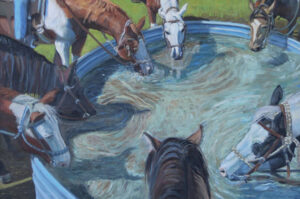


Beauty in the Paint
A group of artists with The Realist Project celebrate the characteristics of Paint Horses in their artwork.
By Kelsey Ritchie
Featured artwork: “Watering Paints” by Tom Delheimer
Featured artwork: “Dinner Out” by Kathryn Walker Richardson
With the stroke of a brush, Kathryn Walker Richardson swirls acrylic paint around the canvas, glancing back and forth at a photograph that started it all. Focusing on the spot of red-orange popping out amongst the green grass, she dances the brush over the brown base with white paint, creating a unique and sporadic pattern.
It was an idyllic scene that inspired Kathryn to pull her car over on the side of a dirt road and venture out to the deep orange blur that had caught her eye in the middle of the Oklahoma pasture. As she approached, she saw it wasn’t a blur at all, but rather a small, brightly colored foal.
“I was driving down this road, which I have done hundreds of times, but when I saw that pop of orange, I knew I had to check it out,” Kathryn said. “That’s the artist in me coming out.”
 This serendipitous discovery was the driving inspiration behind the next several months of Kathryn’s—and nine other artists—work as part of Catch a Painted Pony, an Oklahoma City art exhibit featuring the American Paint Horse.
This serendipitous discovery was the driving inspiration behind the next several months of Kathryn’s—and nine other artists—work as part of Catch a Painted Pony, an Oklahoma City art exhibit featuring the American Paint Horse.
“I don’t think any of my subjects have caused me to appreciate the art found in nature quite like this one,” Kathryn said. “Growing up around Quarter Horses and Appaloosas, I always admired Paints because of how their patterns could go from very clean lines to extremely random and seemingly splattered.”
 For the next several weeks, Kathryn and the other artists in The Realist Project—a rotating group of artists based in Oklahoma who gather to work on a narrowly focused subject for an exhibit—traveled around north-central Oklahoma to various farms and ranches, hunting for the splashes of color in the otherwise neutral-and earth-toned fields.
For the next several weeks, Kathryn and the other artists in The Realist Project—a rotating group of artists based in Oklahoma who gather to work on a narrowly focused subject for an exhibit—traveled around north-central Oklahoma to various farms and ranches, hunting for the splashes of color in the otherwise neutral-and earth-toned fields.
“We got to talk to a lot of different owners of Paint Horses while we were traveling around,” Kathryn said. “We never had a single owner say that we couldn’t photograph their horse—Paint Horse owners are friendly!”
After gathering ideas, the artists all worked independently, finding their inspiration in different photographs or painting styles.
“This project forced us to look at something we aren’t familiar with. Many people think artists from Oklahoma already know how to paint horses, but we don’t—horses are one of the most difficult things to paint.
 “We focus on representational art. Art is either conceptual or perceptual. Conceptual is nonfigurative and non-objective, whereas perceptual is the opposite, focusing on recognizable objects. That’s what representational is—someone can look at the painting and know what it represents. All of our paintings looked realistic. Representational art is thriving in America.”
“We focus on representational art. Art is either conceptual or perceptual. Conceptual is nonfigurative and non-objective, whereas perceptual is the opposite, focusing on recognizable objects. That’s what representational is—someone can look at the painting and know what it represents. All of our paintings looked realistic. Representational art is thriving in America.”
The eclectic mix came together to form Catch a Painted Pony, and the exhibit was on display in Oklahoma City from June 6–27. It featured more than 40 paintings offered for sale by the 10 artists.
“The show went really well,” Kathryn said. “We lost count of how many people came through. On opening night, it was standing room only. We had refreshments and old cowboy music playing. It was a lot of fun.”
The idea of an exhibit featuring a single subject matter dates back to the 1800s, Kathryn explains. Artists would have themed shows in the salons in Paris or across Europe; the tradition continues today, and themed shows help draw the connection to the history of the craft.
Kathryn has already started sculpting plans for the future.
“Now that I have done so much research on Paint Horses, I would like to continue painting them simply because the anatomy of the horse is just so intriguing. When you pair that with the natural beauty of coat patterns, it makes for beautiful artwork,” Kathryn said. “Paints make painting easy.”
SHARE THIS